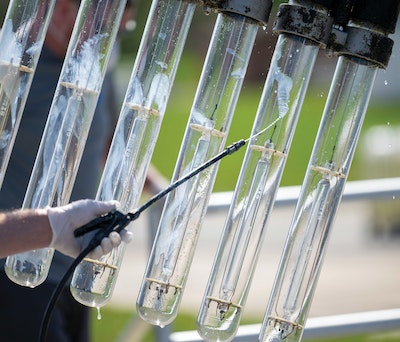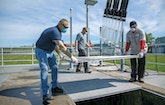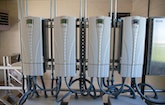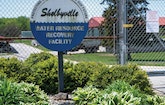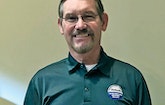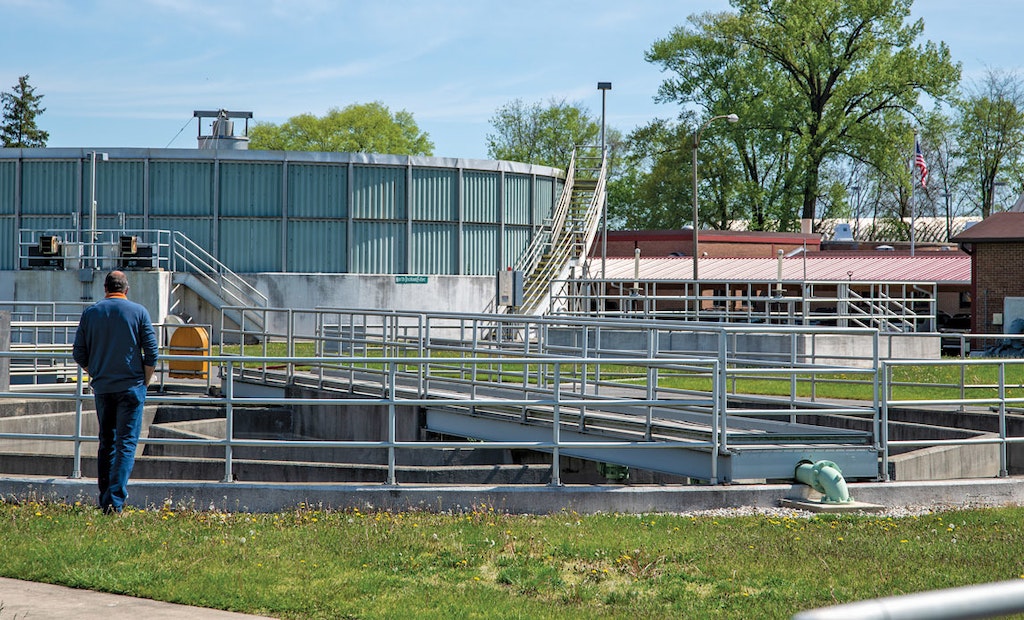
The Shelbyville facility achieves nitrogen and phosphorus removal through a combination of trickling filters and aeration.
Interested in Inflow and Infiltration?
Get Inflow and Infiltration articles, news and videos right in your inbox! Sign up now.
Inflow and Infiltration + Get AlertsThanks to the energy of management and staff, the Shelbyville (Indiana) Water Resource Recovery Facility has significantly reduced its energy use.
“Our people did much of the work themselves,” says Kevin Kredit, superintendent. “They rewired and reprogrammed equipment, installed variable-frequency drives and figured out how to reduce equipment use — running only two pumps instead of three for example.”
The plant also improved digester gas usage and secured a grant to install solar panels on the grounds. Overall, Kredit says, electricity use has been cut by a third while the costs for energy improvements have been paid back in just over a year.
These are just some of the achievements in which the plant staff can take pride. The facility earned the 2019 Resource Recovery Facility of the Year from the Indiana Water Environment Association. The plant has also received collections system, laboratory and safety awards.
Mix of technologies
The Shelbyville facility achieves both nitrogen and phosphorus removal, using a rather novel design that combines an older trickling filter system with a unique twist on aeration.
Wastewater is collected via 75 miles of sewers and directed to two large pumping stations. One handles flow from the north side of the Big Blue River, including an industrial park; the other takes all domestic and industrial flow from south of the river and includes an in-line double-drum Channel Monster grinder (JWC Environmental).
Four dry-pit submersible pumps (Pentair Fairbanks Nijhuis) move the wastewater through a 24-inch force main under the Big Blue River and into the treatment plant headworks. At the plant, the flow passes through a Parshall flume and two grit chambers. A pair of pumps (Trillium Pumps USA SLC - WEMCO) move the grit to a Gritt Mitt classifier (WesTech Engineering).
Three primary tanks follow; floatables are diverted to collection boxes by a mechanical skimmer. Pentair Hydromatic pumps lift the flow to three high-rate trickling filter towers that are 20 to 25 feet deep and filled with plastic crossflow media that hosts a zoogleal film. Hydraulically driven arms distribute the water over the beds.
Rapid settling
The original facility was designed as a trickling filter plant, “the way of things back in the 1970s and ’80s,” Kredit says. “All our BOD, TSS and nitrogen removal is accomplished through the towers.”
Water then passes through three aeration tanks fed by blowers (Hoffman & Lamson, by Gardner Denver) and coarse-bubble diffusers, but no treatment takes place there. “The aeration just keeps our solids in suspension before final clarification, especially solids that settle off the trickling filters,” Kredit says. That process enhances settling in the final tanks.
The effluent is UV disinfected (TrojanUV) before discharge to the Big Blue River. An ultrasonic metering device calibrated to a 36-inch Parshall flume measures flow at that point. The plant meets its phosphorus removal requirement by dosing with selenium-lanthanum, a rare-earth mixture that reacts with phosphorus to form a dense, fast-settling precipitate.
The mixture is injected just ahead of the aeration basin at 35 gpd: “We found that was the best place to add it. It’s expensive, but it doesn’t add to our solids load.”
Handling solids
Biosolids are digested and thickened before dewatering on a belt press (Komline-Sanderson). In two primary digesters, the material is heated to approximately 95 degrees F and mixed by two Pearth gas mixers (Evoqua Water Technologies) and six gas-bubble boxes at the bottom of each tank.
The sludge is then transferred to a secondary digester where it is stored for seven to 14 days for liquid-solid separation. The secondary digester is not heated or mixed. “We let natural decomposition occur, which causes more liquid-solid separation,” Kredit says.
The plant fully uses the biogas produced in the digesters. A dome-shaped Dystor membrane system (Evoqua Water Technologies), installed in the early 2000s and recently rehabilitated, stores the methane and prevents odors. “We use this gas as a substitute for natural gas to heat our primary digesters,” Kredit says. “We also inject some of the gas back into the digesters to promote stirring and mixing.”
Through a contract with Synagro Technologies, cake at 24% to 27% solids is spread on farm fields.
Control and maintenance
The Shelbyville plant team includes Jim Vierling, collections foreman; Blake Branum, plant lead operator; and Gary Karnes, Larry Karnes, Seth Mohr, Scott Gaudin, Brian Morton and John Barnes, plant operators.
Ed Williams operates the belt press; Bronda Vierling is administrative assistant; Michelle Higdon is lab manager; and Richard Clouse, Dom Huber, Rolland Scudder, Cody Riggs, Kyle Richardson and Richard Richardson take care of the collections system.
The staff keeps a close eye on all levels of treatment without the standard SCADA system. Instead, the facility is equipped with an OmniSite cellular system that alarms the staff in case of any malfunctions on the lift stations and plant equipment.
“OmniSite maintains a website called GuardDog, which our operators monitor for any equipment issues,” Kredit says. “The website alerts us to any failures or issues, as well as high levels in the pumping stations.”
The monitoring system has proven its worth by notifying staff of clogging in pumps, allowing them to remove the blockage before it shuts the pump down. A Google Calendar, adopted five years ago, helps manage plant maintenance, doing away with time-consuming paperwork. “Our staff uses the calendar and a laptop in the control room to schedule regular grease, lubrication, cleaning and other maintenance tasks,” Kredit says.
Good housekeeping
Keeping the processes clean and functioning well is a key component in the plant’s success. For example, regular cleaning of the UV system led not only to more efficient disinfection, but also to a plantwide energy conservation program that has paid off handsomely.
“When I was lead operator back in 2015, we realized we were running our two UV trains at 100% power usage in order to maintain the required kill rate,” Kredit says. “We were using aftermarket parts, and our quartz sleeves, ballasts and lights were fouling regularly.
“We went back to TrojanUV parts and installed all new quartz sleeves. We also implemented a regular system of cleaning and maintaining the system. Once per week, we clean our secondary weirs by manually brushing them in the morning and hand-wiping the sleeves of the UV system after lunch.”
Those procedures enabled the team to lower the setpoint on the UV system without sacrificing treatment. “Instead of two trains operating at 100% power, we now operate one train at about 35% power while maintaining the required kill rate,” Kredit says. “We invested $50,000 in new UV parts and realized payback in just over a year.”
Cutting energy costs
With those savings pocketed, Kredit and his crew looked for other power-consuming functions. First, they went after “low-hanging fruit” and replaced all plant lighting with LEDs. Next, they looked at the power consumption at each process station, mainly pumps and blowers.
“Basically, where we had three pumps or blowers, we were able to take one out of service and still maintain treatment standards,” For example, they found it was possible to lift wastewater to the top of the three trickling filter towers with two pumps instead of three. And since the blowers don’t aerate but only keep solids in suspension, the staff found it acceptable to run just one blower at a time.
They got even more bang for the buck by installing new ABB VFDs. Some of the VFDs dated to 2000; the new ones do a better job of managing power consumption and keeping equipment from running full bore around the clock. They are more user friendly.
“We installed 22 VFDs around the plant and did the work ourselves,” Kredit says. That included all the programming and wiring once the staff had learned the basics from ABB.
Taken together, the efficiency improvements are saving plenty. The plant invested about $140,000 for improvements and has seen a one-third reduction (32.3%) in kilowatt-hours used for a savings of $325,000 (28.2%) over the last five years.
While saving money, the energy-efficiency plan also gave the plant staff an opportunity to learn and grow. “I think the lesson we learned here is that when we look deeper, we can find more than what our job description says we are,” Kredit says.
“Through our energy program, we’ve gained a lot of insight. It’s shown us that we’re capable of more. It has given us new things to learn and do, and it’s added to the enjoyment of our jobs.”
